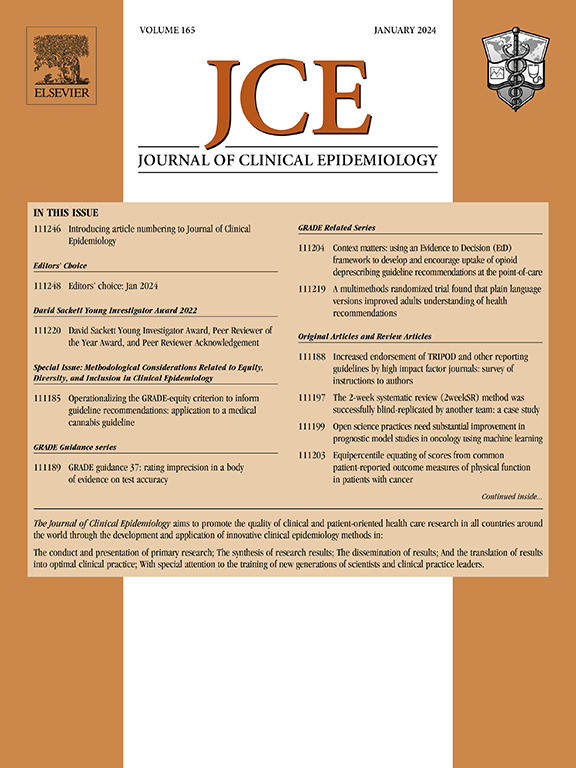现有人工智能报告指南中缺乏方法严谨性和有限的生成人工智能覆盖范围:范围审查。
IF 5.2
2区 医学
Q1 HEALTH CARE SCIENCES & SERVICES
引用次数: 0
摘要
目的:本研究旨在系统地绘制医学中现有人工智能(AI)报告指南的开发方法、范围和局限性,并探索其对生成式人工智能(GAI)工具的适用性,如大型语言模型(llm)。研究设计和设置:我们报告了一项范围评价,遵循系统评价和荟萃分析范围评价扩展的首选报告项目(PRISMA-ScR)。检索了MEDLINE(通过PubMed)、EQUATOR Network、CNKI、FAIRsharing、谷歌Scholar等5个信息来源,检索时间从建站到2024年12月31日。两名审稿人使用预定义的Excel模板独立筛选记录并提取数据。数据包括指南特征(例如,开发方法、目标受众、人工智能领域)、对EQUATOR网络建议的遵守以及共识方法。差异由第三位审稿人解决。结果:纳入了68条人工智能报告指南。48.5%的人专注于通用AI,而只有7.4%的人专注于GAI/ llm。方法的严谨性是有限的:39.7%描述了开发过程,42.6%涉及多学科专家,33.8%遵循EQUATOR的建议。存在明显的重叠,特别是在医学影像方面(20.6%的指南)。gai特定指南(14.7%)缺乏全面覆盖和方法透明度。结论:医学中现有的人工智能报告指南在方法严谨性、冗余性和对人工智能应用的覆盖不足方面不够理想。未来和更新的指南应优先考虑标准化的开发过程、多学科协作,并扩大对法学硕士等新兴人工智能技术的关注。本文章由计算机程序翻译,如有差异,请以英文原文为准。
Lack of methodological rigor and limited coverage of generative artificial intelligence in existing artificial intelligence reporting guidelines: a scoping review
Objectives
This study aimed to systematically map the development methods, scope, and limitations of existing artificial intelligence (AI) reporting guidelines in medicine and to explore their applicability to generative AI (GAI) tools, such as large language models (LLMs).
Study Design and Setting
We reported a scoping review adhering to the Preferred Reporting Items for Systematic Reviews and Meta-Analyses extension for Scoping Reviews. Five information sources were searched, including MEDLINE (via PubMed), Enhancing the QUAlity and Transparency Of health Research (EQUATOR) Network, China National Knowledge Infrastructure, FAIRsharing, and Google Scholar, from inception to December 31, 2024. Two reviewers independently screened records and extracted data using a predefined Excel template. Data included guideline characteristics (eg, development methods, target audience, AI domain), adherence to EQUATOR Network recommendations, and consensus methodologies. Discrepancies were resolved by a third reviewer.
Results
Sixty-eight AI reporting guidelines were included; 48.5% focused on general AI, whereas only 7.4% addressed GAI/LLMs. Methodological rigor was limited; 39.7% described development processes, 42.6% involved multidisciplinary experts, and 33.8% followed EQUATOR recommendations. Significant overlap existed, particularly in medical imaging (20.6% of guidelines). GAI-specific guidelines (14.7%) lacked comprehensive coverage and methodological transparency.
Conclusion
Existing AI reporting guidelines in medicine have suboptimal methodological rigor, redundancy, and insufficient coverage of GAI applications. Future and updated guidelines should prioritize standardized development processes, multidisciplinary collaboration, and expanded focus on emerging AI technologies like LLMs.
求助全文
通过发布文献求助,成功后即可免费获取论文全文。
去求助
来源期刊

Journal of Clinical Epidemiology
医学-公共卫生、环境卫生与职业卫生
CiteScore
12.00
自引率
6.90%
发文量
320
审稿时长
44 days
期刊介绍:
The Journal of Clinical Epidemiology strives to enhance the quality of clinical and patient-oriented healthcare research by advancing and applying innovative methods in conducting, presenting, synthesizing, disseminating, and translating research results into optimal clinical practice. Special emphasis is placed on training new generations of scientists and clinical practice leaders.
 求助内容:
求助内容: 应助结果提醒方式:
应助结果提醒方式:


